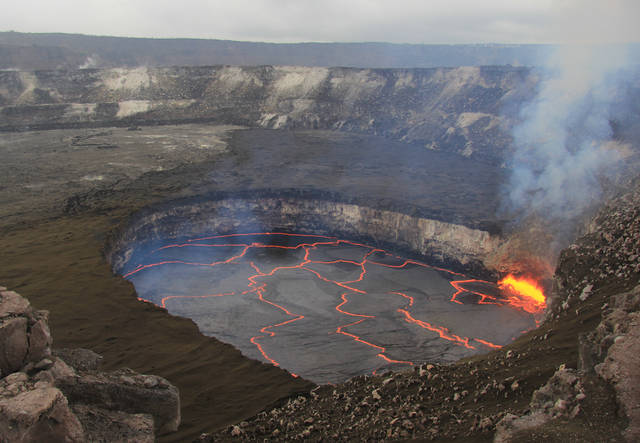The U.S. Geological Survey released a documentary last week chronicling the history of Kilauea volcano’s ongoing summit eruption.
The U.S. Geological Survey released a documentary last week chronicling the history of Kilauea volcano’s ongoing summit eruption.
The 24-minute film, titled “Kilauea Summit Eruption — Lava Returns to Halema‘uma‘u,” uses historical photos and modern high-definition video of the volcano to tell the story of Halema‘uma‘u and the lava lake atop Kilauea’s summit that has steadily expanded since 2008.
Featuring narration by former University of Hawaii at Hilo professor Jackie Pualani Johnson, the documentary explains the efforts by the USGS to study the lava lake in order to glean more knowledge about the planet’s volcanic processes.
While the film touches on the history and significance of Halema‘uma‘u — a sacred place traditionally believed to be the home of Pele, the volcano goddess — the focus of the film is the lake’s modern history, which began with an explosive eruption in 2008.
In March 2008, a vent at Halema‘uma‘u exploded, scattering burning debris across the area and marking the first eruption in the crater since 1982.
Since then, the vent has widened to more than 800 feet across, eventually forming one of the two largest lava lakes in the world, rivaled only by that of Mount Nyiragongo in the Democratic Republic of the Congo.
The film also features commentary from scientists at the USGS Hawaiian Volcano Observatory describing their methods, as well as a chant by retired kumu hula and UH-Hilo professor Pualani Kanaka‘ole Kanahele.
Halema‘uma‘u will enter its 10th year of eruption next March. Its lava lake is the longest-lasting lava lake on Kilauea since 1924.
However, because of the dangers inherent of an active volcano, the crater is closed to the public.
The full documentary can be found on the USGS’s official YouTube channel, USGS, or at the Hawaiian Volcano Observatory’s website.
Email Michael Brestovansky at mbrestovansky@hawaiitribune-herald.com




